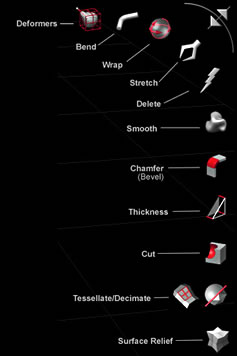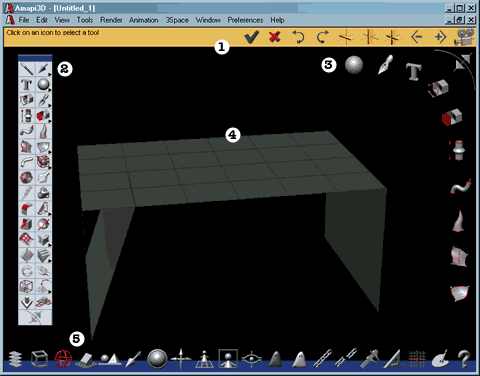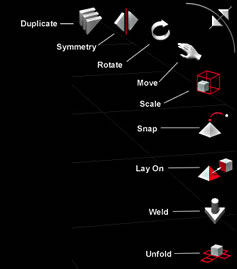![]()
![]()
AMAPI 6.1w
by Hawk Jones
Amapi is the quirky little nugget of gold 3D modeler that has been around since hector was a pup and is just now finally coming into its own. Amapi was originally distributed under the TGS banner until recently when it bought out the developer Eovia to create a separate identity for the product. Eovia also owns the old MetaCreations product Cararra, which will be reviewed in this issue of the KotaPress Art Journal as well.
In the past Amapi has had a reputation of being very unstable and while the program still crashes occasionally much effort has been put into making the latest release 6.1 more solid. Wait, but that's not all, the upgrade also includes new Flash, Shockwave 3D Exports and owners of Amapi 6.0 can upgrade for free! While Amapi is primarily a 3D modeler it does offer some basic animation capabilities which should appeal to web designers when you factor in Flash, Shockwave 3D Exports and new the Web 3D and dynamics system called 3Space.
Models can easily be exported into a wide variety of file formats, 25 to be exact and rendered in other applications like Vue d'Esprit, Bryce, 3D Studio Max, LightWave...
Interface
The interface takes a whole lot of getting use to given the number of
iconic commands many of which are not very intuitive. In point of fact
Amapi really has two interfaces, a "Standard" interface which
presents all of the modeling features in a single palette and the "Workshop"
interface which doles out tools as you need them.
The interface is divided into 1) The assistant palette 2) Standard interface option displays all modeling and editing options 3) Workshop Interface displays options in palettes that change as the user move the cursor pointer outside the viewer window 4) Modeling table can be used to help visualize perspective 5) Control panel used to orient views, show/hide objects, link/unlink objects... .
Once you get a handle on where everything is and what everything does,
the interface really begins to fit like pair of old shoes.
Modeling
While the interface is at first a bit cumbersome to use, the modeling
process is really quite simple. Basically you use two tools to create
primitives and curves, after which every other tool modifies the object
you created. When using the "Workshop" interface, Amapi divides
its tools into a number of palettes which are called Construction, Modeling,
and Assembly.
|
Construction Palette In addition to primitives Amapi features a drawing tool that produces a wide variety of polygon or NURBS curves like circle, rectangle, curve, helicoid, etc.... The curve tool generates a curve controlled by points in a manner reminiscent of bezier curves. In fact if you dig deep enough into Amapi, you'll find an option to create real bezier curves. The final curve creation tool is the text editor which converts TrueType text, entered by way of a text box, into Polygon of NURBS curves. |
 |
All the remaining tools in the construction palette are used to manipulate created curves, and it is here where Amapi really shows its stuff.
Extrusions and sweeps can be accomplished on a facet, edge, or vertex of a shape which provides tremendous versatility in curve manipulation, not to mention a few unexpected surprises from time to time. Double Sweeping generates a surface from a section and two profiles which is great for making horns and other pointy things. Rules Surface, akin to loft in other 3D applications, basically creates a surface between curves. Surfaces are very cool and very powerful as you can create a surface, or skin, over a variety of curves.
OK, now the downside. Do not expect any of this to work the way you expect
it to work. For  example,
you might expect a sweep to work by drawing a single curve and sweeping
it 360 degrees, right? Wrong, first you must create a section, in other
words a circle, and then ever so carefully attach a perpendicular profile
curve and if all goes well you'll be rewarded with the shape you wanted.
If the profile is not in exactly the right spot you get zip, or worse
like the dreaded internal error alert followed by an application crash.
You'll get use to saving your work often when modeling with Amapi.
example,
you might expect a sweep to work by drawing a single curve and sweeping
it 360 degrees, right? Wrong, first you must create a section, in other
words a circle, and then ever so carefully attach a perpendicular profile
curve and if all goes well you'll be rewarded with the shape you wanted.
If the profile is not in exactly the right spot you get zip, or worse
like the dreaded internal error alert followed by an application crash.
You'll get use to saving your work often when modeling with Amapi.
|
Modeling Palette The modeling palette offers tools to fine tune the rough shapes created in the Construction palette. Deformer tools can twist, bend, taper, and spherize shapes. Other tools can stretch, bevel, smooth, and delete facets, edges, points, or entire objects. The thickness tool adds thickness to the inside or outside of an object; very cool. The cut tool does more than just boolean stuff. It also can extract a portion of the current object to making a new object in the process. Tessellate subdivides a facet into four facets, and when combined with the smooth tool, offers some of the rudimentary functionality found in subdivision modelers. |
 |
|
Is your surface too smooth? Forget about bump maps just try the
Surface Relief tool which can either bump a surface or soften it.
I had mentioned earlier that Amapi can convert 2D gray scale images
into 3D mesh, now with the wrap tool you can wrap the mesh around
just about any object. In fact you can wrap an object, like text,
around another object, like a sphere. |
|
|
Assembly Palette All told, Amapi is a very powerful modeler with a low price tag and a high learning curve. It will take you some time to get use to the interface and all of those strange icons. But, beyond that, the real work is learning the nuances of each tool and the causal effect that one tool has on another. If you are willing to invest the time and have the patience to endure the occasional application crash, then you will be rewarded handsomely. |
|
Output
If modeling is Amapi's strength then traditional 3D rendering and animation
is Amapi's weakness. That said, Eovia has made a concerted effort to extend
Amapi's output options beyond "traditional rendering" and into
the World Wide Web. With the introduction of Amapi 6 came a web-based
3D dynamic presentation system called 3Space. Models exported to 3Space
are converted to the ZAP file format for streaming dynamic 3D images to
browsers. However, 3Space is a browser plug-in which is not widely distributed
at present. In my estimation the real news is the introduction of Flash
and Shockwave 3D output in Amapi 6.1, which is a free upgrade to Amapi
6 users. Eovia has also released a free plug-in for 3D Studio Max 4 which
seamlessly transfers Amapi models from within Max. The Amapi materials
editor has also been improved with a newer, kinder interface.
Summation
OK, it's got a quaky interface, it's modeling tools a somewhat unconventional,
it crashes more than most, and it's documentation isn't that great. All
that aside Amapi is an application capable of producing world class models
at a fraction of the cost of it's nearest competitor. If you are in the
market for a modeler then I strongly suggest you download the Amapi demo
and give it a spin.
 |
||
| Product | Amapi 6.1w | |
| Cost | US $ 399 | |
| Developer | Eovia | |
| URL | http://www.eovia.com/ | |
| System Requirements | Windows: |
Pentium II 300Mhz or better, Windows 98/2000/NT 4.0 (with SP3 or later), 64 MB of Physical RAM, 24-bit Color Display, 3D graphics accelerator card recommended, CD-ROM Drive, 100 MB free hard drive space. |
| Mac |
Power Macintosh G3 266 Mhz or better, System 8.1 or later, 64 MB of application RAM, 24-bit Color Display, 3D graphics accelerator card recommended, CD-ROM Drive, 100 MB free hard drive space. |
|

